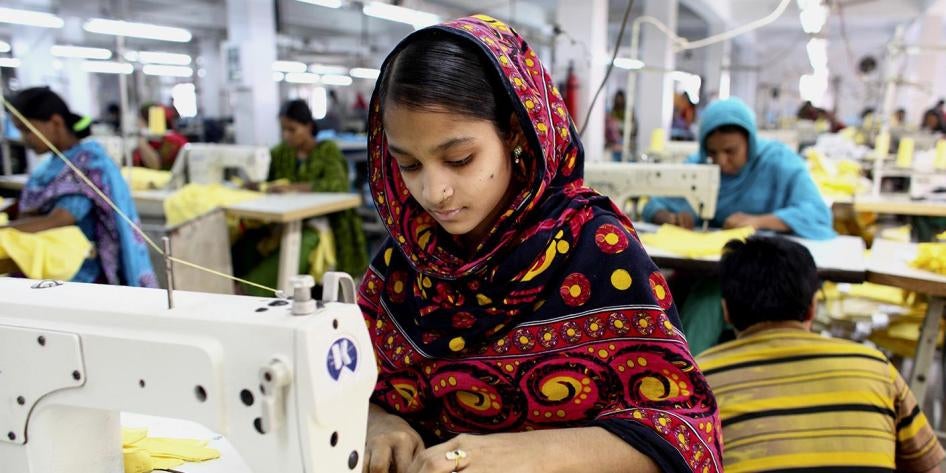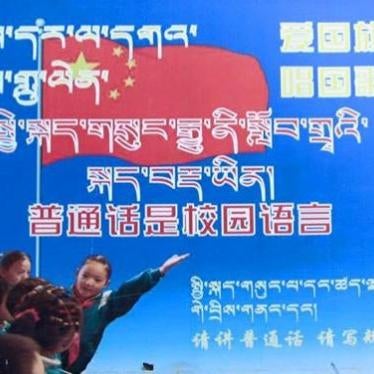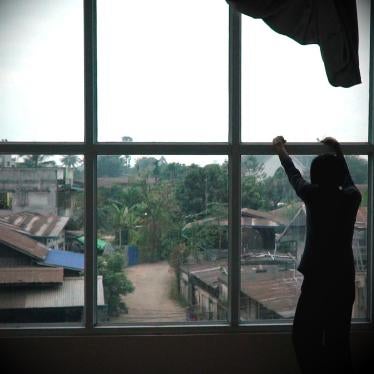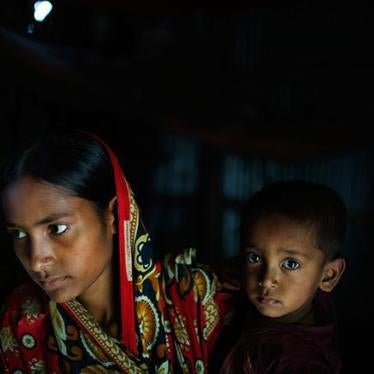 孟加拉成衣工人在发生倒塌事故的热那大厦(Rana Plaza)附近工厂里操作缝纫机。
© 2014 G.M.B. Akash / Panos
孟加拉成衣工人在发生倒塌事故的热那大厦(Rana Plaza)附近工厂里操作缝纫机。
© 2014 G.M.B. Akash / Panos
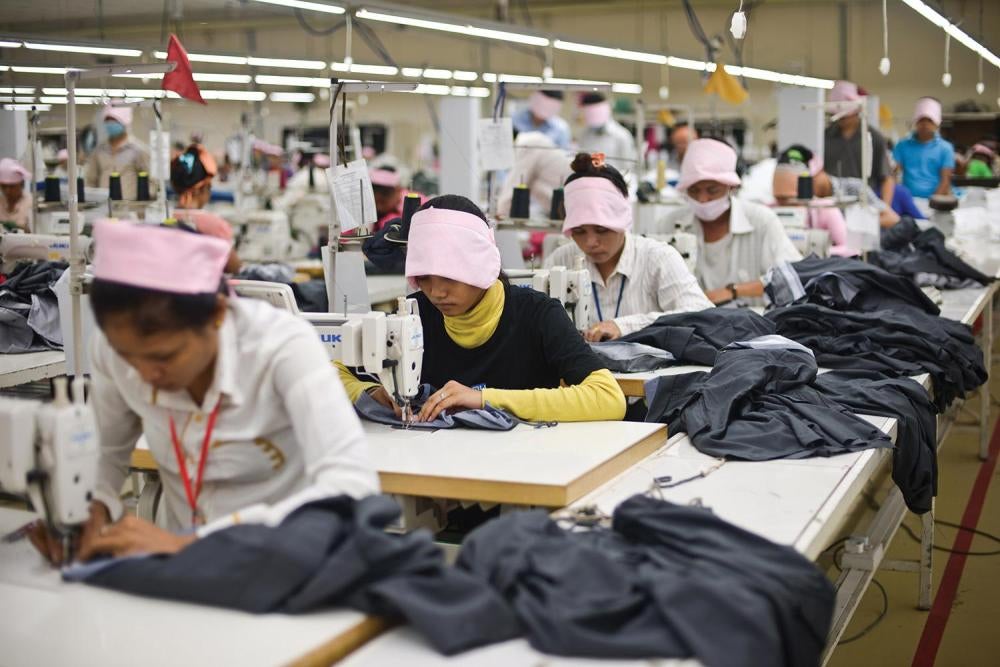 Women in the sewing division of a factory in Phnom Penh, Cambodia’s capital. Women constitute about 90 percent of the workforce in Cambodia’s garment industry.
© 2014 Samer Muscati/ Human Rights Watch
Women in the sewing division of a factory in Phnom Penh, Cambodia’s capital. Women constitute about 90 percent of the workforce in Cambodia’s garment industry.
© 2014 Samer Muscati/ Human Rights Watch
 Victims of the 2013 Rana Plaza building collapse and their families demonstrating at the site of the disaster demanding full compensation.
© 2014 G.M.B. Akash/Panos
Victims of the 2013 Rana Plaza building collapse and their families demonstrating at the site of the disaster demanding full compensation.
© 2014 G.M.B. Akash/Panos
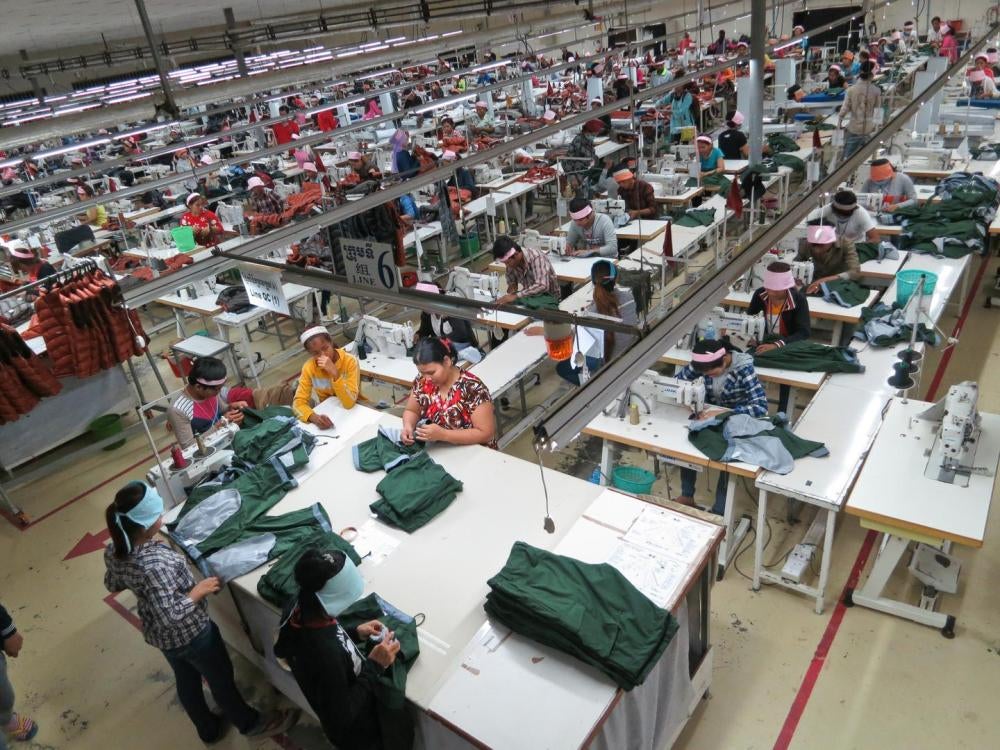 柬埔寨首都金边一家成衣厂的女工。女性占柬埔寨纺织业劳动力的九成,为许多国际流行品牌生产成衣。但据人权观察纪录,柬埔寨劳工经常必须忍受强迫加班、怀孕歧视,而且无法获得带薪生育假。
© 2014 Samer Muscati/人权观察
柬埔寨首都金边一家成衣厂的女工。女性占柬埔寨纺织业劳动力的九成,为许多国际流行品牌生产成衣。但据人权观察纪录,柬埔寨劳工经常必须忍受强迫加班、怀孕歧视,而且无法获得带薪生育假。
© 2014 Samer Muscati/人权观察
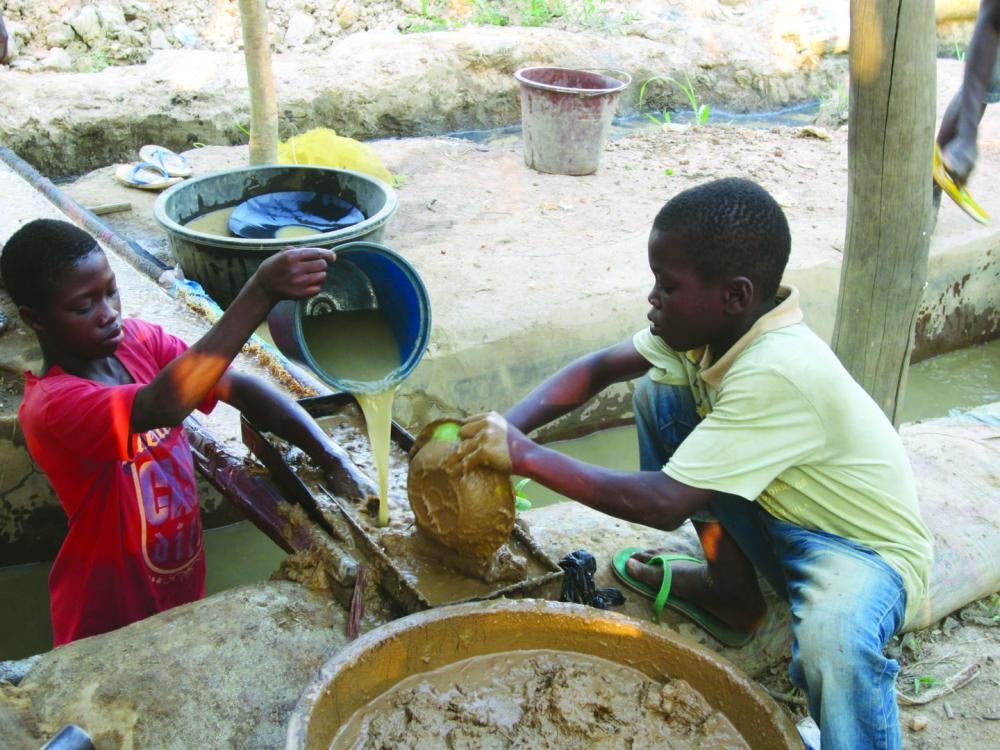 Ghana is one of the world’s top 10 gold producers. Around one-third of Ghana’s gold is mined in artisanal and smallscale mines, which mostly operate illegally and use child labor. Two boys, 9 and 12 years old, demonstrate their daily work of washing and sluicing gold ore in Homase, Amansie Central district, Ashanti Region.
© 2014 Juliane Kippenberg/Human Rights Watch.
Ghana is one of the world’s top 10 gold producers. Around one-third of Ghana’s gold is mined in artisanal and smallscale mines, which mostly operate illegally and use child labor. Two boys, 9 and 12 years old, demonstrate their daily work of washing and sluicing gold ore in Homase, Amansie Central district, Ashanti Region.
© 2014 Juliane Kippenberg/Human Rights Watch.
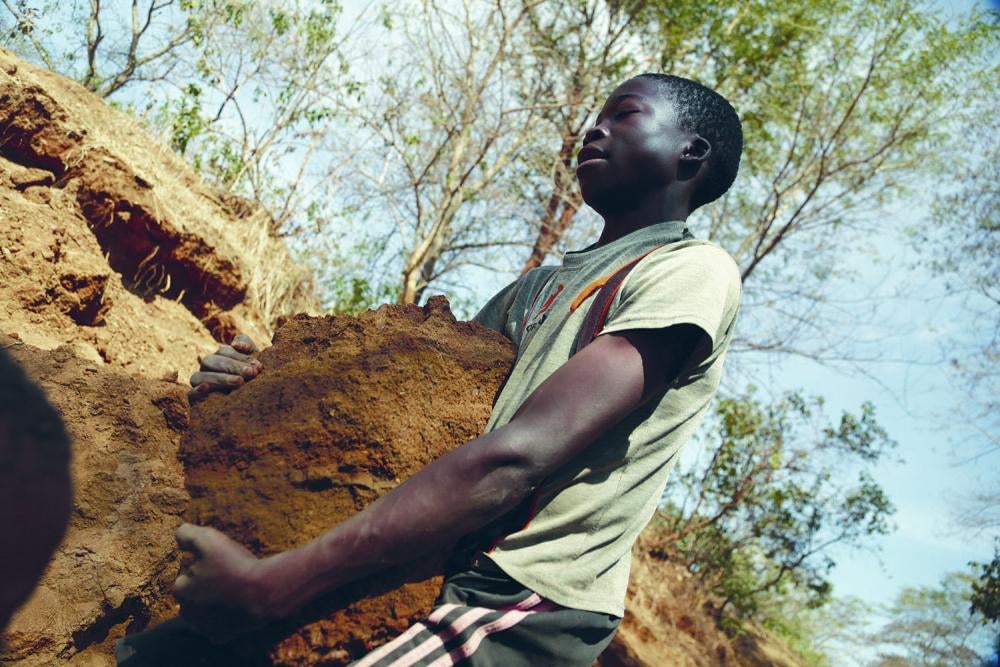 A 13-year-old boy digs for gold ore at a small-scale mine in Mbeya Region, Tanzania. “I was digging with my colleague,” he said. “I entered into a short pit. When I was digging he told me to come out, and when I was about to come out, the shaft collapsed on me, reaching the level of my chest … they started rescuing me by digging the pit and sent me to Chunya hospital.” The accident knocked the boy unconscious and caused internal injuries. He remained in the hospital for about a week and still occasionally feels pain in his waist when he sits. After the accident, he was scared of returning to the pits, but he felt he had no choice, explaining: “Whenever my aunt travels is when I go, because I need something to sustain myself.” Companies trading in gold have a responsibility to ensure that they do not cause or contribute to child labor.
© 2013 Justin Purefoy/Human Rights Watch
A 13-year-old boy digs for gold ore at a small-scale mine in Mbeya Region, Tanzania. “I was digging with my colleague,” he said. “I entered into a short pit. When I was digging he told me to come out, and when I was about to come out, the shaft collapsed on me, reaching the level of my chest … they started rescuing me by digging the pit and sent me to Chunya hospital.” The accident knocked the boy unconscious and caused internal injuries. He remained in the hospital for about a week and still occasionally feels pain in his waist when he sits. After the accident, he was scared of returning to the pits, but he felt he had no choice, explaining: “Whenever my aunt travels is when I go, because I need something to sustain myself.” Companies trading in gold have a responsibility to ensure that they do not cause or contribute to child labor.
© 2013 Justin Purefoy/Human Rights Watch
 一名16 岁的烟草工人穿着工作服站在北卡罗莱纳州烟草农场上。
© 2015 Benedict Evans 为人权观察摄影
一名16 岁的烟草工人穿着工作服站在北卡罗莱纳州烟草农场上。
© 2015 Benedict Evans 为人权观察摄影
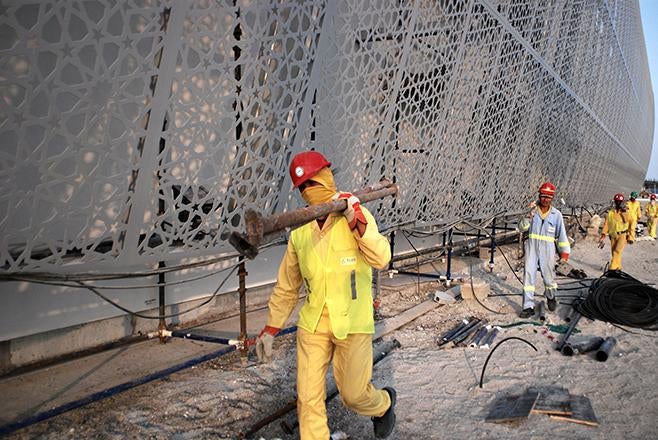 Drawn by the promise of jobs, thousands of men from India, Pakistan, Bangladesh, Sri Lanka, and Nepal are working on Saadiyat Island in the United Arab Emirates.
© 2010 Samer Muscati/Human Rights Watch
Drawn by the promise of jobs, thousands of men from India, Pakistan, Bangladesh, Sri Lanka, and Nepal are working on Saadiyat Island in the United Arab Emirates.
© 2010 Samer Muscati/Human Rights Watch
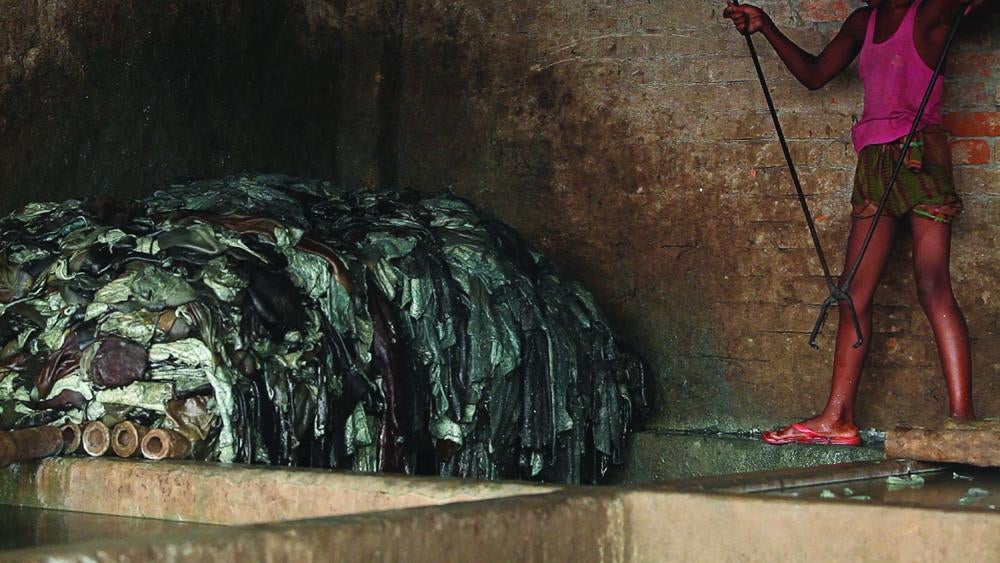 A boy uses tongs to soak hides in a pit of diluted chemicals in a Hazaribagh leather tannery. Even though international law binding on Bangladesh and Bangladesh’s own labor law prohibit employing children under 18 in harmful or hazardous work, many children work in Hazaribagh’s leather tanneries.
© 2012 Arantxa Cedillo/Human Rights Watch
A boy uses tongs to soak hides in a pit of diluted chemicals in a Hazaribagh leather tannery. Even though international law binding on Bangladesh and Bangladesh’s own labor law prohibit employing children under 18 in harmful or hazardous work, many children work in Hazaribagh’s leather tanneries.
© 2012 Arantxa Cedillo/Human Rights Watch
 被安置到莫瓦拉济(Mwaladzi)的女性农民,只能分配到缺乏水源的贫瘠土地。补偿方案还包括一栋新房子。“我们分到的耕地都是红土,不是以前家乡的黑土。我试着种过玉米,但种不活。种高粱也失败了。...我不怎么满意。我只能说,没有食物的房子有什么用?房子又不能当饭吃,”玛莉亚・C说。
© 2012 Samer Muscati/人权观察
被安置到莫瓦拉济(Mwaladzi)的女性农民,只能分配到缺乏水源的贫瘠土地。补偿方案还包括一栋新房子。“我们分到的耕地都是红土,不是以前家乡的黑土。我试着种过玉米,但种不活。种高粱也失败了。...我不怎么满意。我只能说,没有食物的房子有什么用?房子又不能当饭吃,”玛莉亚・C说。
© 2012 Samer Muscati/人权观察
(日内瓦)-人权观察在今天发布的报告中表示,2016年国际劳工大会各国代表应发起拟订一份具拘束力的国际公约,在全球供应链上保障人权。2016年5月30日起,世界各国政府、雇主和劳工将聚集日内瓦,出席这场劳工界的年度高峰会议,讨论如何在全球供应链上确保“尊严劳动”。
具有法律拘束力的规则,是确保公司不致剥削劳工或助长侵犯劳工权利的唯一实际途径。
Juliane Kippenberg
人权观察儿童权利部副主任朱莉安妮・基朋柏格
这份21页的报告,《供应链人权:呼吁制订尽职调查全球标准》,内容基于人权观察二十年来对于全球供应链之中的儿童劳工及其他劳动权侵害、环境破坏和违反健康、土地、食物及用水等权利的研究。
“全世界数百万人正因企业不良作为和政府疏于规管而遭受人权侵犯,”人权观察儿童权利部副主任朱莉安妮・基朋柏格(Juliane Kippenberg)说。“具有法律拘束力的规则,是确保公司不致剥削劳工或助长侵犯劳工权利的唯一实际途径。”
报告凸显全球供应链存在各式各样的人权侵犯,包括:为全球消费者生产品牌服装和鞋类的工厂侵犯劳工权利、打压工会;种植烟草出售给全球香烟制造商的农场使用童工从事危险工作;营造部门移民工的劳动权利遭到严重侵犯;以及为全球市场挖掘黄金的手工采矿者常因意外事故丧生。
全世界估计有4.5亿人为全球供应链工作。企业日益依赖跨越多国的复杂供应链取得商品与服务。人权观察发现,各国政府常疏忽其保护人权的职责,未能在国内及国外有效规管企业活动。我们并发现,许多企业未充分做到人权尽职调查,已使侵权得以更加泛滥。有鉴于此,人权观察表示,国际劳工大会出席代表们应当为一份具有拘束力的公约铺平道路,使各国政府可据以要求所有企业建立人权保障机制或“尽职调查”,并贯彻到整个全球供应链。
企业有责任实施有效的人权尽职调查,包含客观评估个别企业的人权风险,及其减轻或避免风险的有效措施。对于在防范措施下仍然遭受侵害的民众,企业也有责任协助确保其能够得到适当救济。在通过法律法规强制实施人权尽职调查的国家,企业会受到激励而采取积极行动。
“光靠关于人权与商业的自愿性标准是不够的,”基朋柏格说。“有些企业对它热烈欢迎,其他企业却漠不关心,把本身应负的人权责任丢在一边。本届国际劳工大会是改变这个毫无效率的自由放任体制的难得契机。”
《联合国商业与人权指导原则》是不具拘束力的企业人权责任国际标准,它界定了人权尽职调查的主要内容。根据此一《联合国指导原则》,企业本身的活动及其与供应商之间的关系均应确保尊重人权。
在很多方面,该指导原则已为负责任的商业行为建立一套有用的框架──其正当性已获得各国政府、企业和工会广泛接受。然而,由于这套标准本质上仍属自愿性质,对于不守规范的行为仍无法加以处罚。
为全球供应链上的人权尽职调查制定一项具有法律拘束力的新标准,有助解决前述问题。而这项新标准应当建立在《联合国指导原则》的基础上。
2013年4月孟加拉热那大厦(Rana Plaza)倒塌事故,曾使成衣业恶劣工作条件和侵害劳工权利的问题受到注目。热那大厦倒塌造成逾1,100名工人死亡,2千多人受伤。三年来,虽然孟加拉在消防和建筑物安全方面已有所改进,但成衣和鞋类供应链仍然存在严重的人权问题。一名工会人士在2016年告诉人权观察,她因为工会活动而遭到殴打和死亡威胁。
“由2013年热那大厦灾难可见,劳动法律规管和执法的缺失可能造成多么恐怖的后果,”基朋柏格说。“很明显的,我们急需制定一项有拘束力的全球供应链人权标准,才能确保企业履行人权责任。”










